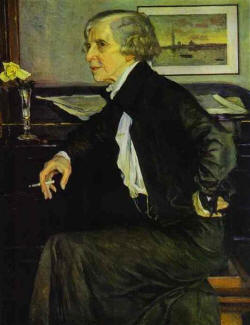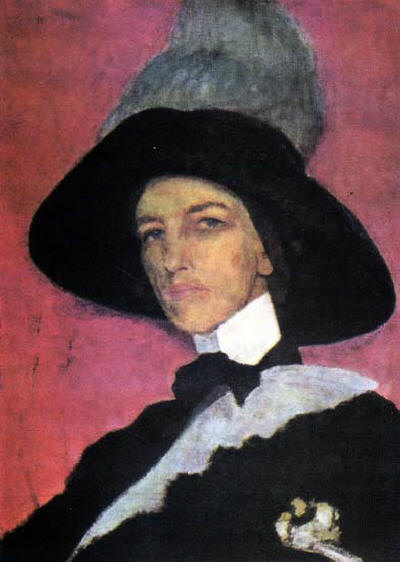

Queer Places:
Académie Colarossi, 10 Rue de la Grande Chaumière, 75006 Paris
17 Rue Boissonade, 75014 Paris, France
Literatorskie Mostki
Saint Petersburg, Saint Petersburg Federal City, Russia
 Elizaveta Sergeyevna Kruglikova (19 January (31 January New Style) 1865, St. Petersburg – 21 July 1941, Leningrad) was a Russian-Soviet painter, etcher, silhouettist and monotypist.
She was a lesbian who invested her creativity in the act of unveiling her
gender ambiguity. Her masculine style included participation in male sports,
such as long-distance cycling and mountain climbing. The artist and her
girlfriend, Mademoiselle Sellier cycled from Paris to Brittany around 1905,
wearing special cyclist trousers (the cycle bloomers) which were still
considered to be rather shocking in provincial France.
Elizaveta Sergeyevna Kruglikova (19 January (31 January New Style) 1865, St. Petersburg – 21 July 1941, Leningrad) was a Russian-Soviet painter, etcher, silhouettist and monotypist.
She was a lesbian who invested her creativity in the act of unveiling her
gender ambiguity. Her masculine style included participation in male sports,
such as long-distance cycling and mountain climbing. The artist and her
girlfriend, Mademoiselle Sellier cycled from Paris to Brittany around 1905,
wearing special cyclist trousers (the cycle bloomers) which were still
considered to be rather shocking in provincial France.
She was born in Saint Petersburg to Sergey Nikolaevich Kruglikov (1832-1910) and Olga Yuliyevna Neyman (1836-1922). Her father was a military officer who was an amateur painter, and her grandfather, Nikolai Alexandrovich Kruglikov (1788–1868), was a professional painter. In 1880, she lived with her father in Poltava, where she first met artists associated with the Peredvizhniki and decided on art as a career. From 1890 to 1895, she attended classes at the Moscow School of Painting, Sculpture and Architecture, where she studied with Illarion Pryanishnikov, Sergei Korovin and Abram Arkhipov.[1] In 1895, she continued her studies in Paris at the Académie Colarossi and the Académie Vitti.[2] She set up her own studio in 1900 and, from 1902, studied etching with Joseph-Victor Roux-Champion (1871–1953). While in Paris, Paul Gauguin was a regular guest at the studio of Elizaveta Kruglikova, which was frequented by the young Russian artists who studied painting in Paris. After 1909, she was also a teacher at the Académie de La Palette.[1] At the beginning of World War I, she returned to Saint Petersburg and became associated with Mir Iskusstva. In 1916, she published a book of monotypes called Paris on the Eve of the War and donated the proceeds to Russian artists who were stranded in France.[1] In 1919, she was one of the founders of the State Puppet Theater, where she also designed puppets.[3] This was a predecessor to the State Central Puppet Theater established by Sergey Obraztsov in 1931. From 1922 to 1929, she was a Professor at the Higher Art and Technical Studios (formerly the Imperial Academy of Arts), where she taught theatrical and decorative painting. She also designed posters and published a popular series of silhouettes, Poets, followed by another on Leaders of the Revolution.[2] A prolific exhibitor, she participated in virtually all of the shows held in the Soviet Union as well as several abroad, including the Venice Biennale (1928).[1] Kruglikova was the subject of a pencil portrait in 1933 by Pyotr Neradovsky[4] and paintings by Mikhail Nestorov in 1938 and 1939. Inactive throughout much of the 1930s, she went to Moscow in 1939 to help organize an exhibition featuring works by the former members of Mir Iskusstva. She was known for reviving older etching and printing techniques, such as the mezzotint and aquatint, but was especially well known for monotypes.[2] In 2009, the Fourth International Festival of Monotypes was dedicated to her. Elizaveta Kruglikova died on 21 July 1941 in Leningrad (previously, and again today, St. Petersburg).

Selfportrait
.jpg)
Kruglikova by Nesterov, 1939
Elizaveta was a younger sister of Nikolai Sergeyevich Kruglikov (16 November [28 New Style], 1861, St. Petersburg - 28 October 1920, Petrograd), an engineer best known for his service as deputy chief of construction of the Ussurian Railway (Vladivostock-Khabarovsk). He served under two successive chiefs of construction, Alexander Ivanovich Ursati (March 1891-October 1892) and Orest Polienovich Vyazemsky (October 1892-November 1897).[5][6][7] In 1909 he was one of the founders of the Intimate Theater Art Society. Elizaveta painted a portrait of her brother[8] in 1910, an excellent likeness of Nikolai Sergeyevich sitting on the porch of his country home and holding a book.
My published books: